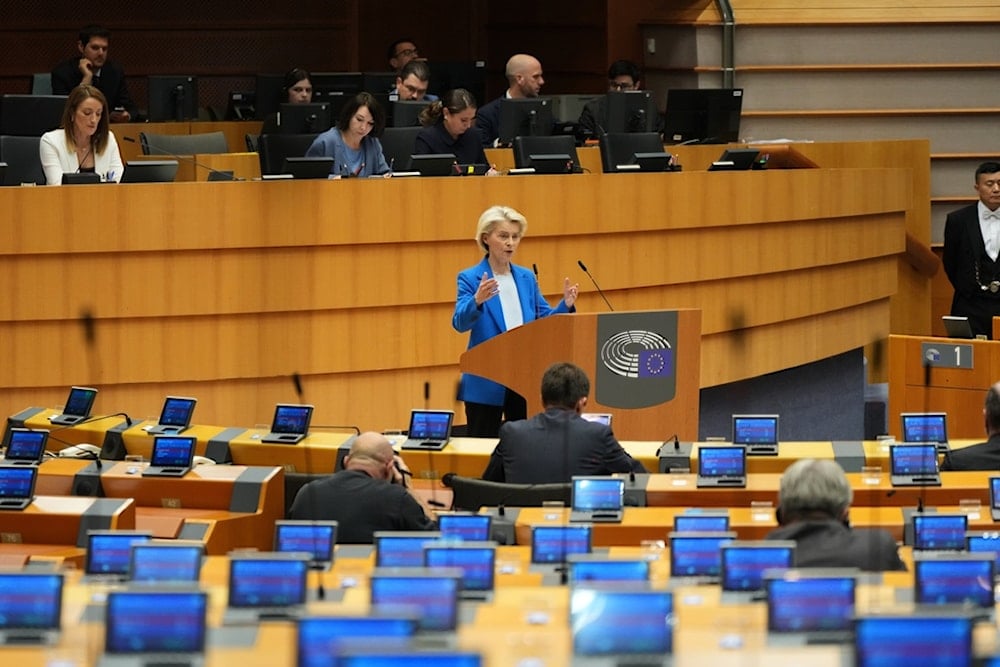EU mulls €90Bln loan for Ukraine, separate from frozen Russian assets
The EU is advancing a €90 billion borrowing plan for Ukraine while struggling to reach consensus on a separate, legally complex proposal to use frozen Russian assets as backing for a larger reparations loan.
-

European Commission President Ursula von der Leyen addresses the plenary on the 2028-2034 Multiannual Financial Framework at the European Parliament in Brussels, Belgium, Wednesday, Nov. 12, 2025 (AP Photo/Virginia Mayo)
The European Commission is urging member states to back a major financial package for Ukraine that would rely on fresh EU borrowing rather than on Russia's immobilized central bank reserves.
A letter circulated by Commission President Ursula von der Leyen to EU leaders on Monday outlines a proposal for a 90-billion-euro loan to Kiev, to be raised on international capital markets.
According to the document, Brussels is presenting this approach as an alternative to using the frozen Russian Central Bank assets as collateral. Instead, the Commission suggests issuing EU-backed debt, with the entire amount guaranteed by national governments.
Von der Leyen’s letter makes clear that the financial responsibility for the package rests squarely with member states. The interest generated by the financing would be covered collectively by EU capitals.
As the document states, "the interest costs on the loan will also be borne entirely by EU countries." It further notes that if any government opts out of participating, the remaining states would be required to compensate, ensuring full coverage of the loan.
"If one country refuses to contribute, all other countries will have to increase their contributions proportionally to ensure 100% coverage," the letter says.
Frozen Assets Deadlock
In parallel to this loan proposal, EU institutions are still debating whether and how to involve Russia's frozen sovereign assets in broader support for Ukraine. Since the beginning of the war, the EU and G7 have immobilized nearly US$300 billion in Russian central bank reserves, most of which are held in Europe, particularly at Euroclear in Belgium. These assets remain legally owned by Russia but cannot be accessed due to sanctions.
While member states have already agreed to channel the profits generated by these immobilized funds, roughly $8 billion in 2023, a full-scale plan to use the assets themselves remains stalled. Proposals put forward in late October and reiterated in November include using up to €185 billion of these frozen reserves as backing for a large-scale "reparations loan." Under this model, the EU would borrow against the assets while avoiding outright confiscation, with Ukraine repaying the loan only if Russia eventually pays reparations.
Although the United States has publicly endorsed this approach, calling it a legitimate tool to support Ukraine, Europe remains divided. Belgium, hosting Euroclear and therefore carrying the bulk of the exposure, continues to demand strong legal guarantees against Russian retaliation and insists that any financial or legal fallout be shared among all member states. Brussels has warned that failure to reach an agreement could leave EU governments paying up to €5.6 billion annually in ongoing interest obligations on the frozen funds.
Critics also caution that leveraging sovereign assets in this way risks damaging confidence in Western financial systems, potentially accelerating a shift by non-Western countries toward alternative reserve structures, including gold, commodities, or non-Western financial institutions.
EU leaders have therefore not yet reached consensus, and discussions are set to continue. As von der Leyen told the European Parliament on November 13, member states essentially face three options: draw on unused EU budget headroom, coordinate national fundraising, or proceed with a reparations loan backed by immobilized Russian assets, the option she called the "most effective" for sustaining Ukraine’s defense and economy.
However, with legal, political, and operational uncertainties still unresolved, the EU is continuing to search for a mechanism that is both internationally defensible and politically acceptable, without exposing member states to disproportionate financial or diplomatic risk.
Read more: Macron, Zelensky sign deal for up to 100 Rafale jets

 4 Min Read
4 Min Read









